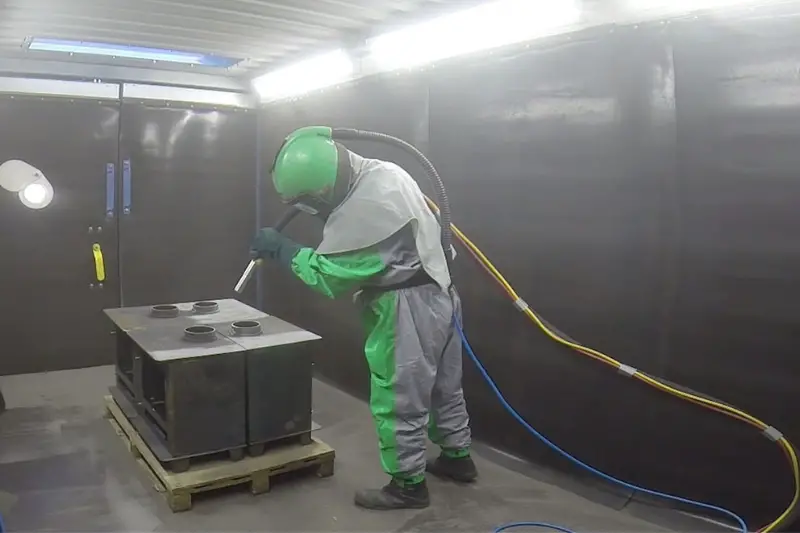Click here to get this post in PDF
The blasting process removes paint and other coatings without damaging the surface underneath. This makes it ideal for stripping complex, delicate surfaces such as the aluminum missile airframe below. The shape of abrasive particles has a significant impact on the way they interact with the blasted surface. Blast media with a sharp, knife-like structure will cut at a substrate, while more blunt and rounded particles, such as crushed glass, will peen the surface.
Environmentally-Friendly
While sandblasting can cause significant damage to thin metal and delicate surfaces, plastic media blasting is an environmentally-friendly alternative. It uses significantly less pressure and stress on the surface being worked on, and the abrasive material can be recycled for reuse instead of creating hazardous waste. Environmentally friendly plastic blasting media such as urea, melamine, and acrylic are typically angular abrasive materials that work well for cleaning and stripping a wide range of materials, especially delicate aluminum composites or other sensitive substrates. These abrasive media are made from recycled urea, polyester, or acrylic and are free of silica and other toxins. They also have a long lifespan and work well for most enclosed blasting machines. They’re ideal for mold cleaning, stripping, deflashing, and general surface preparation.
Effectively Removes Paint
Media blasting uses abrasive materials such as glass beads, aluminum oxide, or plastic granules fired under high pressure to remove contamination through abrasion. This allows the removal of paint, rust, and grease from metal parts and components without damaging them. This method of surface preparation is much faster and more efficient than other coating removal methods, such as chemical strippers, acid sprays, and manual sanding, and is considered environmentally friendly because it creates no hazardous waste. Softer abrasive materials like crushed urea or sodium bicarbonate can also be used for non-destructive paint removal. Unlike hard silica sand, these reusable blasting media can be used at lower blasting pressures, less likely to damage or etch the substrate. This makes them ideal for applications with delicate or thin underlying surfaces.
Reduces Dust
This process can be environmentally friendly depending on the blast media type used. Biodegradable abrasives such as ground nut shells or fruit seeds are often used and easily disposed of in the open air. Plastic blast media is also ideal for sensitive work, such as cleaning or stripping aluminum composites or cryogenic deflashing applications. It is less abrasive than traditional sand or shot blasting and does not generate heat that can warp or pit surfaces. Additionally, the low dust levels produced by this blasting method make it more viable in tighter spaces than conventional abrasive blasting. Its nozzle-based design guides the blast media through an air stream to the cleaned surface. This prevents unwanted impacts on nearby components or structures. This also reduces rework and downtime due to damaged substrates.
Increases Productivity
A pressure blasting system can be used for more aggressive operations, such as stripping powder coating from hard-to-reach areas, or for faster cleaning rates than a suction-based system. The pressure system also allows for the nozzle to be moved more quickly over the workpiece and for the blast media to reach a higher velocity at the nozzle, allowing for more excellent coverage of the workpiece. Plastic blast media works well on soft substrates like aluminum, copper, brass, injection molds, and other composite materials. It is reusable and recyclable, unlike many other blasting media that break down too quickly for economical reclaiming. It also reduces or eliminates the use of toxic chemicals and acid strippers that require expensive, hazardous waste disposal.
Safer
Plastic media blasting is a safer alternative to other methods of industrial cleaning. Unlike abrasive media, like silica sand, plastic particles don’t have sharp edges that can damage the substrate. The soft, angular plastic blasting media also reduces the pressure applied to the stripped surface. The blasting media can be recycled and reused for multiple projects, reducing waste. Additionally, the media doesn’t contain toxic chemicals that can harm people or animals, making it a safer option for delicate surfaces. Blasting with plastic media is a safe choice for predictable results when stripping sensitive surfaces, such as automotive metals and aerospace materials. Urea and melamine are the most commonly used plastic blasting media, offering a Mohs hardness between 3 (calcite) and 4 (fluorite). These are the softer grades of plastic blasting media and offer the flexibility to strip various surfaces without damaging them.
You may also like:
Why Professional Commercial Cleaning & Facility Maintenance Are Essential for Colorado Businesses
Five Different Types of Floor Cleaning Machines and Their Benefits

